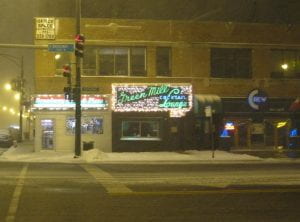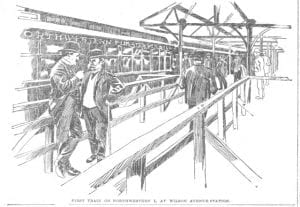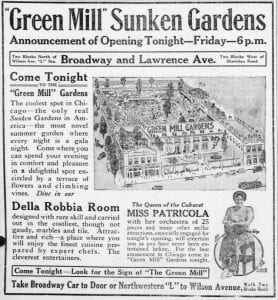Green Mill Cocktail Lounge: Uptown’s splendor during the Jazz Age
Author: Flory Huang
Program of Study: Master of Arts Program in the Social Sciences (MAPSS), Division of the Social Sciences (SSD)

(Source: https://commons.wikimedia.org/wiki/File:Green_Mill_Cocktail_Lounge.jpg)
As I was wandering on the Chicago Neighborhood website, hoping to find something exciting to write about, one article caught my eye: “5 Chicago neighborhoods for music lovers”. “This is it,” I thought, I have found my gem on this site. For the past half-year, I have been really into live music and I’m interested to know where I can continue my music experience in Chicago. In the article, Uptown is the first neighborhood mentioned with the oldest Jazz Bar in Chicago, the Green Mill. I have heard that Chicago has a great history in Jazz. As I dug deeper, I found that Uptown’s connection with Jazz isn’t just the Green Mill, but it also reached a peak during the Jazz Age (1920s and 1930s). So I decided to look into Uptown through the lens of the Green Mill: How was it developed in Uptown, What was its impact on the neighborhood in the early 20th century?
The development in the 1900s

The train station. (Source: https://www.wbez.org/stories/from-cemetery-saloons-to-movie-palaces-how-uptown-became-an-entertainment-hub/ff35dc6f-fcde-4ca4-81e5-22fe33947291)
The development of Uptown was related to transportation. Since the Northwestern Elevated Railroad opened a stop at Wilson and Broadway, Uptown became a resort place for downtown Chicagoans in 1900 (Loerzel, 2020). As the train brought many tourists and residents to the neighborhood, shops started to open in the Uptown area. Some businessmen saw the potential of Uptown and decided to make it a shopping center for Chicago. The Central Uptown Chicago Association started to promote Uptown as a “Shopping Center of a Million People” (Loerzel, 2020). The Association tried to build Uptown as a big shopping district for all people in the city, The dramatic increase in population in Uptown can demonstrate how much influence the train and shopping center brought to the neighborhood. In 1900, only around 2300 people lived in Uptown while in 1930, its population reached 67,699 (Loerzel, 2020); in comparison, in 2019 there were just 58,979 residents (Uptown, n.d.).The increase in population and shops created demands for entertainment in the area. Three types of activities were most popular around that time: cabaret, movies, and dancing. Many famous venues that supported those activities were opened during this period, and the Green Mill was one of them.

Newspaper about the opening of the Green Mill in 1914. (Source: https://www.wbez.org/stories/from-cemetery-saloons-to-movie-palaces-how-uptown-became-an-entertainment-hub/ff35dc6f-fcde-4ca4-81e5-22fe33947291)
Being close to the train station, the Green Mill was located in a popular location that could bring it many customers. As early as in the 1880s, the site of Green Mill had Pop Morse’s Garden built on it, serving as a roadhouse for travelers to rest and have meals (Jazz Age Chicago–Green Mill Gardens, 2011). In 1914, Morse’s Roadhouse was turned into the Green Mill, a bar for entertainment and relaxing. After several years’ development, the Green Mill reached its golden age during the Jazz Age (1920s and 1930s), when it had many famous Jazz musicians’ performances regularly, including Billie Holiday and Al Jolson (Sisson, 2014).
Connection with African American culture and community
Since Jazz had a deep connection with African American Culture, it’s interesting that the Green Mill, a landmark in Chicago Jazz History, was built in Uptown, an almost all-White community in the early 20th century (Uptown, n.d.). The development of Jazz in Chicago is associated with the Great Migration, the movement of African Americans from the Southern part of the US toward Northern cities, which brought large numbers of African Americans into Chicago (Chicago Sound, n.d.). Jazz originated in New Orleans, Louisiana, and was significantly influenced by African dance and drumming (Jazz Origins in New Orleans—New Orleans Jazz National Historical Park, n.d.). The Great Migration brought the black community along with their love of Jazz toward Chicago. The demand for Jazz in Chicago attracted many Jazz musicians in New Orlean to move there.
Although Chicagoans had developed an interest in Jazz, they did not accept the black community as they accepted their music. Discrimination was still a big problem in the city, especially in the northern part. The Green Mill was one of the first places in the Northern part of the city that would book the black jazz band. Because the demographic data showed that Uptown remained to be an almost all-white neighborhood through 1960 (Uptown, n.d.), it was hard to say that Jazz and those African American musicians brought any significant changes to the black community in Uptown. But when the white audiences listened to the music that was originated from and performed by African Americans in the Green Mill, there must have been a moment that they thought about their bias and prejudice toward this group of people.
Connection to gangster history

The Green Mill bar on a busy Saturday night. “At left is a small table behind the bar honoring Al Capone.” (Source: from:https://en.wikipedia.org/wiki/Green_Mill_Cocktail_Lounge)
The flourishing of the Green Mill and Jazz in Uptown also had an association with gangster history in Chicago. During the Prohibition Era (1920-1933), when alcohol was banned in the United States, the Green Mill was partially owned by Jack “Machine Gun” McGurn, a key member of the Chicago Outfit-a crime syndicate (Sisson, 2014). Thus the bar was under the control of Al Capone, McGurn’s crime boss. Al Capone was one of the most famous crime bosses in the United States who was based in Chicago. He visited the Green Mill regularly and had a reserved seat. Al Capone turned the Green Mill into a Speakeasy, where people could buy illegal liquor, and had Jazz musicians perform in it (Sisson, 2014). At that time, Capone owned over 10,000 speakeasies in the city. His love for Jazz had it chosen as the live music played in the speakeasies to attract more patrons. The performances in speakeasies saved Jazz musicians from poverty and provided them a steady income (The Rise of Jazz and Jukeboxes – Prohibition: An Interactive History, n.d.). The work at speakeasies provided Jazz Musicians with stable living conditions, helping them focus on their music and promoted the development of Jazz, which also explained why the Jazz Age overlapped with the Prohibition Era. In the 1920s, the Green Mill helped many Jazz musicians and the development of Jazz in Chicago; now, these past Jazz superstars, in turn, made the Green Mill famous.
In the 21 century
The splendor of Uptown and the Green Mill in the Jazz Age was captured by this 1930s advertisement: “Make tomorrow an Uptown Chicago Day — shop in the morning, swim in the afternoon, and dance or see a show in the evening ” (Loerzel, 2020). I can almost imagine a Gatsby scene happening in Uptown through this description: Flapper girls wearing glitter dresses that spark under the sun; Women carrying large shopping bags; people chatting in the bars; dancing in the ballrooms. Uptown in the Jazz Age sounds like it was a great relaxing place to have all the fun in the world. Although we can no longer experience its splendor in the Jazz Age, you can still get a sense of its past magnificence through the night-long jazz performances in the still open Green Mill.
Nowadays, the Green Mill not only has live Jazz but also is a venue for Uptown Poetry Slam (Sisson, 2014). The Uptown Poetry Slam has oral poetic performances each Saturday night at the Green Mill, bringing this old Jazz bar another form of art. The Green Mill is gradually becoming a unique art community place at the Uptown where people can enjoy music or poems, hang out with friends, or just relax by themselves. It’s a must-see place in Chicago: not only for its history in the Jazz Age but also to get a sense of the current Uptown neighborhood.

The Green Mill front door. (Source: https://en.wikipedia.org/wiki/Green_Mill_Cocktail_Lounge)
References
Chicago Sound. (n.d.). Retrieved August 18, 2021, from http://www.encyclopedia.chicagohistory.org/pages/267.html
Jazz Age Chicago—Green Mill Gardens. (2011, September 27). https://web.archive.org/web/20110927070750/http://chicago.urban-history.org/ven/dhs/grn_mill.shtml
Jazz Origins in New Orleans—New Orleans Jazz National Historical Park (U.S. National Park Service). Retrieved August 19, 2021, from https://www.nps.gov/jazz/learn/historyculture/history_early.htm
Loerzel, R. (2020, July 5). Why Are There So Many Music Venues In Uptown? WBEZ Chicago. https://www.wbez.org/stories/from-cemetery-saloons-to-movie-palaces-how-uptown-became-an-entertainment-hub/ff35dc6f-fcde-4ca4-81e5-22fe33947291
Sisson, P. (2014, March 20). An oral history of the Green Mill. Chicago Reader. http://chicagoreader.com/music/an-oral-history-of-the-green-mill/
The Rise of Jazz and Jukeboxes – Prohibition: An Interactive History. (n.d.). Retrieved August 19, 2021, from https://prohibition.themobmuseum.org/the-history/how-prohibition-changed-american-culture/jazz-and-jukeboxes/
Uptown. (n.d.). Retrieved August 16, 2021, from http://www.encyclopedia.chicagohistory.org/pages/1293.html
Leave a Reply
You must be logged in to post a comment.